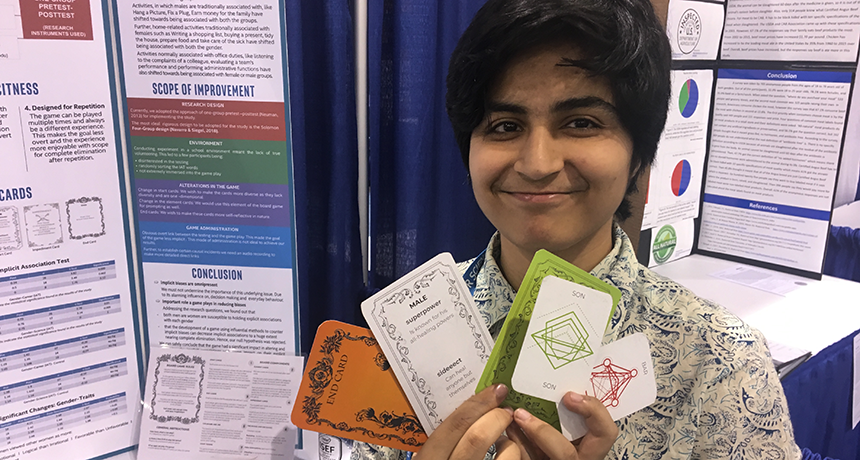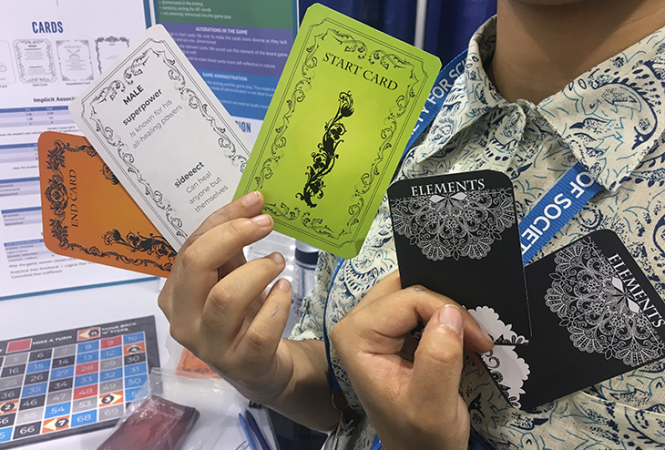Game may help rid people of biases they didn’t know they had
A teen designed the game to help people see different points of view

Magon, 18, shows off a game that they made to reduce bias.
B. Brookshire/SSP
PHOENIX, Ariz. — After one too many experiences with bias, Prerna Magon, 18, had had enough. The teen decided to do something about it. But directly confronting people’s intolerance usually doesn’t make them change their ways. In fact, this often makes them defensive and angry. So Magon decided to disguise a new bias-busting program as a role-playing game. By having fun and telling a story, teens who play this game became a little less biased without even realizing it.
Magon just graduated from the Police DAV Public School in Jalandhar, India. They had always been interested in psychology, a study of the mind. But the inspiration for the project came when they switched high schools.
Magon’s physical traits meant they were labeled a girl at birth. But Magon realized that they were a boy. In an attempt to fit in, this transgender student had attended school as a girl. Only a couple of students knew that Magon identified as a boy. (Magon now uses they/them pronouns.)
Then, they say, “Somebody outed me when I became head of the student council.” When members of the council found out that Magon was transgender, “They took my post away.” The council members told them “I could not represent their school.”
Magon transferred to a new school for their senior year. And it was here that they started to design a game to see if they could change people’s implicit biases. These are prejudices that people hold without knowing it. For example, someone might implicitly associate nursing or teaching with women. But both men and women can be teachers or nurses.
The challenge in dealing with implicit biases is that people don’t tend to know they hold them. Yet “they come up in your day-to-day decision-making,” Magon says. “You don’t even realize you’re making a biased decision a lot of the time.” People might automatically assume a scientist is a man, or an artist is a woman.
Magon didn’t want to just tell people they were being biased. After all, everyone wants to think they are fair. Confronting them about bias, Magon notes, “can lead to resentment.” But if people are just playing a game or telling a story, Magon reasoned, they might change their biases without realizing it.
Game on
Magon invented a role-playing game called “Tell Tall Tales.” It’s based on a deck of cards. Each player draws cards, including a card that begins the game — and a card that can end and win the game. Each player also draws a character card, which will give them some superpower. It might be healing, for example. Or they might become a natural leader — someone able to convince anyone to do anything. Character cards also have sexes listed on them — male, female or no sex at all. But each character’s superpower comes with a side effect. A woman who is a leader, for example, might be seen as bossy.

Once everyone gets their character, they have to tell a story. Each player has to develop their own character and interact with the others. Players try to take over the story so that they can play their ending card first. This will bring their own story to an end, allowing them to win the game. But if they make mistakes, they have to draw challenge cards. These describe actions they will have to add into the story. A quiet, artistic male character who can draw anything, for instance, might now have to do something quite out of his character, such as give a difficult public speech. The player with that character had better start twisting the story to make it happen.
Magon slipped six different ideas from psychology into their game that make players think about their biases. The first is “perspective taking.” By handing out cards with characters, the game makes players step into someone else’s shoes. Then there’s counter-stereotyping. A stereotype is an idea that is widely held, but isn’t always true — such as the idea that only men are scientists. By giving the characters traits that run counter to stereotypes, Magon hopes the game will make players think of stereotypes in new ways.
Through role-playing, players can make their characters grow. This helps players view their characters as real, complex people, not just some “female doctor,” or “male nurse.” Imagination also is important. Studying how the characters play out the game can help lessen someone’s initial bias, Magon says.
Different situations in the game encourage players to talk about implicit biases. But it doesn’t force them to. Magon hopes players will feel more comfortable about bringing it up as part of the storytelling. Finally, by playing together in a group, players can’t act on their bias. They need to work together. In the end, Magon says, “There’s no us and them; that reduces your bias.”
Who wins? Everyone
Magon tested 75 students at two high schools. They divided the students into four groups. Two groups first took the Implicit Affinity Test (IAT). This online test measures someone’s implicit bias (you can take the test yourself). One group took the test to see if they had implicit biases about which genders go into which careers. The other took the test to see if they had gender biases about science. Then, all played Magon’s game. Afterward, they took the IAT again, to see if their implicit biases had changed.
Two other groups served as a control group. They just took the IAT twice but never got to play the game.
The students didn’t want to take the tests, but they did want to play the game. “They really liked it,” Magon says. “They never figured out what the purpose [of the game] was. [But] they kept asking what the purpose of the tests were.”
Students who played the game had less implicit bias on the second IAT test than did those who never got to play. The game’s impact on behavior might only last a day or two, Magon says. But if people play the game enough times, Magon hopes their biases may change for good.
As a finalist here at the Intel International Science and Engineering Fair, or ISEF, Magon showcased the game as their entry project. Society for Science & the Public created and runs ISEF. (The Society also publishes Science News for Students.) This year’s competition, sponsored by Intel, brought together more 1,800 students from 80 countries.
The IAT doesn’t always predict how people will behave, and people’s scores on the test often change. But Magon hopes that businesses and other groups might one day use the game to try to reduce bias in the workplace. Many businesses require bias training, Magon notes. It would be much more fun to play games instead.
Adam Dylewski/Explainr







